Chinatown bus lines
Chinatown bus lines are discount intercity bus services, often run by Chinese Americans and Chinese Canadians, that have been established primarily in the Chinatown communities of the East Coast of the United States and Central Canada since 1998, although similar services have cropped up on the West Coast. They operate in 24 U.S. states and 3 Canadian provinces. The vast majority of Chinatown bus lines are based out of the Northeast U.S.
The buses have been subject to controversy because of safety issues, with several fatal incidents having happened over the years. Some companies have been shut down either temporarily or permanently by regulatory authorities, while others continue to operate subject to increased safety checks. The low-overhead, low-fare services have been popular, helping to drive down the prices of competing services such as Greyhound, Megabus and BoltBus.
History
Early history
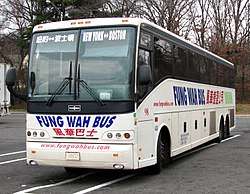
By the late 20th century, intercity bus service in the United States had fallen from 140 million annual passengers in 1960 to 40 million in 1990.[1][2] The decline was such that by 1997, the year Chinatown buses started operating, intercity bus transportation accounted for only 3.6% of travel in the United States.[3]
Chinese-operated intercity bus service originated that year when the Chinese working class found a necessity to travel from New York City, Boston, and Atlantic City. The first companies to offer such intercity bus services offered minimal features, including unmarked curbside bus stops as well as no advertisements and no customer service,[4] which drastically reduced overhead for Chinatown bus lines.[5] In 1998, two intercity bus companies commenced routes: the Fung Wah Bus, between New York City and Boston, and the Eastern Shuttle and New Century Travel and Tours (now Focus Travel), between New York City and Philadelphia.[6] The bus services originally transported workers in Chinese restaurants to and from jobs in Boston, Atlantic City, Cherry Hill Mall, Philadelphia, and Washington, D.C., among other cities.[7][8] Very few non-Chinese people rode on the lines at first.[2][9]
As word of these services spread, they became more popular with non-Chinese travelers.[2][7][10] By 2003, the demographics of Chinatown bus riders and of larger-corporation bus riders were about the same.[11] Reasons cited for the increase in ridership included lower fares and more authentic Chinatown experiences.[2] Between 1997 and 2007, Chinatown buses took 60% of Greyhound Lines' market share in the Northeast United States;[12] Riders of Chinatown buses made up over half of the riders of Northeast intercity buses during that time, bringing total ridership of intercity buses in the area to more than 7 million annual riders.[2]
Competition from newly enriched companies, as well as the commencement of online ticket sales,[7] caused a severe reduction in fares by 2002.[8][13] In these "fare wars", fares were reduced fourfold in some cases,[8][9] and many bus operators advertised their $10 bus fares.[14] This led to gang violence in which rival bus operators would kill or injure each other.[8] In addition, because of the low bus fares, Chinatown bus lines often made very small profits, and some, like YO! Bus, went bankrupt and ceased all operations.[9] Still, the Chinatown bus sector made up an increasing number of trips within the Northeast United States.[5]
Since the late 2000s, competition has come from larger corporations, such as Megabus, BoltBus, Washington Deluxe, and Vamoose Bus.[2][15] Two of the operations—Eastern Shuttle and Today's Bus—were brought under Megabus operation.[4] Another one, BoltBus, was formed by Greyhound in order to compete with the less expensive Chinatown buses.[11]
Increasing scope
_MCI_102DL3_51104.jpg)
Some bus lines are used to transport large groups of mainly Chinese and Vietnamese immigrants to and from casinos such as Foxwoods Resort Casino and Mohegan Sun, which are located in Connecticut. These gambling buses built upon the popularity of older bus routes to Atlantic City that also targeted Asian American customers. Similarly in Canada, several bus lines such as Safeway Tours operate between Toronto and the casinos of Niagara Falls, Ontario.[16]
Increasing popularity has also led to increasing regulatory interest. For example, in September 2004, the city of Boston required all regularly scheduled intercity bus services to operate exclusively to and from the South Station transportation terminal.[7][17][18] Steven Bailey of The Boston Globe suggested that the move was motivated by Peter Pan's and Greyhound's interest in maintaining their monopoly on the New York-Boston bus route, and Timothy Shevlin, executive director of the state Department of Telecommunications and Energy, said, "The big dog out there, Peter Pan, is dead set against Chinatown bus lines. They don't want that kind of competition." A complication with this arrangement was that the South Station bus terminal has only 25 gates (along with two departure gates), all of which were used at the time until other companies left.[17]
Organized crime ties
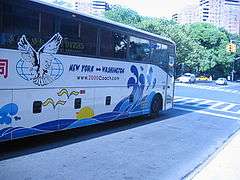
The bus lines have drawn scrutiny from law enforcement authorities for possible connections to Chinese organized crime gangs. In 2003 and 2004, a number of bus arsons, driver assaults, murders, and other gang violence in New York City were linked to the possible infiltration of Asian organized crime gangs into the industry.[19][20]
Among the crimes believed to have been associated with gang activity was a deadly shooting in May 2003, on a busy street, which may have been in retaliation for a driver having backed his bus into a rival;[14] as revenge, two buses were set on fire in 2004.[10] There was a fatal stabbing in October 2003,[8][10] as well as another, unrelated stabbing in 2004.[10] In January 2004, the boyfriend of a bus worker was lethally shot in what appeared to be a bus feud,[8][14] and in March 2004, a Chinatown bus operator was killed in another fatal shooting.[14] In a June 2004 incident tied to criminal gangs, two people—a Chinatown bus driver and a bystander—were murdered in a bar in Flushing, Queens, and another was shot in the leg. The accused shooter was arrested in Toronto in 2011 and extradited to the United States.[10] After the 2004 shootings, the New York City Police Department started enforcing Chinatown bus rules more strictly.[14]
In 2008, the New York Post linked the "Banya Organization" gang with Chinatown buses. The gang allegedly inflicted brutal beatings to coerce private bus and van companies, who were not identified.[21] In 2013, police confiscated 254 guns and arrested 19 people in the largest gun-smuggling ring in New York City's history; the suspects were accused of shipping guns from North Carolina and South Carolina to the Northern United States via Chinatown buses.[22] For the most part, however, bus feud crime has largely subsided.[23]
Vehicles
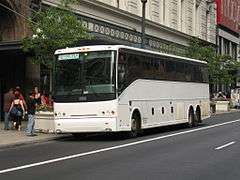
The fleet used by various Chinabus companies can vary greatly from new coaches to older, pre-owned coaches, and with a few notable exceptions such as Eastern Shuttle and routes to Boston, not all units are branded with the operator name other than required USDOT markings.
With the exception of Eastern Shuttle and services to Boston (all of which use clearly marked buses), many Chinatown bus companies use wet leases to provide overflow capacity during the weekend. Some smaller companies use wet leases to provide their core capacity.[24] Typically, a bus (and a driver) would be chartered from a tour bus operator, a practice also used by mainstream companies such as Greyhound Lines during peak service.
Service
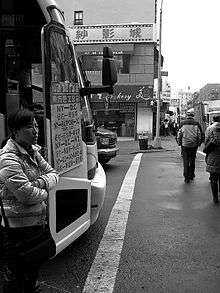
Chinatown buses typically run nonstop express service between the departure and destination points. This typically results in shorter travel times. For instance, the trip from State College, Pennsylvania, to New York City takes about four hours on the Chinatown bus, compared to more than seven hours on Greyhound. However, although the Chinatown buses are often cheaper than alternative modes of transport like Amtrak and airplanes, they are also slower; for example, Amtrak and airplanes take about 2.75 to 3.5 hours to travel from New York City to Washington, D.C., while Chinatown buses take 4 to 5 hours, with a stopover usually in Philadelphia.[2] These intercity buses run at least 2,500 weekly trips.[5]
Many competitors offer discount prices that undercut the major bus lines. Typical fares between East Coast cities range from $10 to $20, compared to major curbside bus lines (which typically cost between $1 and $25), terminal-operated bus lines (which cost between $14 and $35), and Amtrak (which costs about $100.)[2][25] The industry has become highly competitive with companies offering hourly service between major cities.[4][26] The Appalachian extensions of these lines tend to offer less of a price advantage; for example, in August 2006, one-way fares from New York to Pittsburgh on the Chinese-owned All State were $35 compared with $45 advance through Greyhound Lines, while tickets from State College, Pennsylvania, to New York were $35, compared to $46 for Greyhound.[6] Chinatown buses also charge flat fees, while other intercity buses may vary pricing based on demand.[11] Low prices led to high demand for many Chinatown bus routes, and although a single round trip can incur hundreds of dollars in expenses, a fully booked bus can net at least $340 in profits per round trip after these expenses are paid.[9][23]
Often, ticket booths are walk-up windows on the street, or are located inside restaurants and bakeries throughout a given Chinatown community, although it is not uncommon for tickets to be sold on the street directly.[4][23] Some lines even simply collect cash payment after passengers have boarded the bus. However, tickets are often sold online, either by the bus companies themselves or by portals and print-outs of confirmation emails are used as tickets. Except in Boston, the lines rarely use stations of their own. Passengers are usually directed to wait along a given curbside for the arrival of the bus, although many companies offer waiting areas at or near the pickup points. Several bus stops are also near major hotels and in the parking areas of major Chinese supermarkets. In New York, several bus lines pick up passengers on a stretch of Forsyth Street at the foot of the Manhattan Bridge in the Little Fuzhou neighborhood within Manhattan's Chinatown.[7] Since 1998, when the New York City Department of Transportation marked the strip a bus layover area, the sidewalk between Division Street and East Broadway has served as a de facto terminal for the Chinatown buses.[7][27]
Most operators of Chinatown bus lines have traditionally been Fujianese.[14] Often, buses do not follow their scheduled timetables,[7] and many buses are often unreliable, sometimes skipping scheduled stops altogether.[23] In addition, since there are no advertisements and often no websites for these bus lines, knowledge of such bus lines is often spread verbally.[4][23]
Destinations and routes
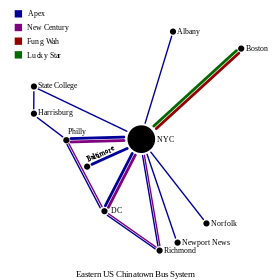
In addition to in Boston and in the various Chinatowns in the New York metropolitan area within New York City and Long Island, several bus line companies also link to the Chinatowns of Edison, New Jersey; Cherry Hill Mall; Philadelphia; Washington, D.C.; Baltimore; Atlanta; and to the casinos of Atlantic City.[4][23] Buses also go to Ohio, Michigan, Rhode Island, Virginia, and Florida.[23] However, Chinatown buses also stop at smaller, predominately non-Chinese areas such as in North Carolina and South Carolina.[4] On the West Coast, buses link the Chinatowns of the San Francisco Bay Area; Los Angeles Chinatown and the San Gabriel Valley; and Las Vegas' Chinatown and casinos. In the I-5 corridor in California, similar services are found in the Hispanic community and provide transportation to/from Baja California in Mexico. Often, the Chinatown bus lines enable Chinese immigrants, mainly restaurant workers, to be transported cheaply along the coasts.[28] In total, the buses travel within 24 U.S. states and Canada.[4]
Many Chinatown buses have their base of operation in New York City, and it has been proposed to build a Chinatown bus hub there.[7] New York-to-Boston Chinatown buses generally use the Massachusetts Turnpike from Boston to I-84, and then follow I-84 to I-91 to I-95. As I-95 approaches New York, several routings are possible depending on the traffic situation.
In Philadelphia, the Independence Transportation Center was built in part due on a 2007 survey by the Philadelphia Chinatown Development Corporation, which concluded that many tourists arrived by bus and that some Chinatown buses disruptively parked on the street. People living closer to Chinatown bus stops in Philadelphia's Chinatown were more likely to complain about the buses.[7][29] Similarly, in Washington, D.C., interim bus loading regulations were enacted in 2008 due to complaints about disruptive bus layovers.[7][30] In Boston in 2004, the Massachusetts Bay Transportation Authority required Chinatown buses to make stops inside South Station and to have permits. Although Fung Wah Bus Transportation was often ticketed for curbside parking offenses in Boston, they eventually became one of two Chinatown buses headquartered in South Station (besides Lucky Star Bus) because the fines for curbside parking were becoming higher than the South Station terminal fees.[7][18]
Besides the routes within the major North Eastern cities, several Chinatown buses have daily routes that run from New York City to Miami. The majority of the trip uses I-95, and the buses stop near major destinations in the Southern United States.[31] A couple of routes also go to Ohio.[32] In order to save time, the buses never go into the city, but instead stop at gas stations and rest stops along I-95.
Chinatown buses often go from major cities to casinos.[33] Some 'Casino Buses' use I-395 to make an intermediate stop at Foxwoods Resort Casino between the Massachusetts Turnpike and I-95. There are several Chinatown buses from New York City to the Wind Creek Bethlehem casino resort in Bethlehem, Pennsylvania. In addition to being used by gamblers who receive free play vouchers, there are several riders, mostly low-income or homeless people, who would sell their free play vouchers upon arriving at the casino and hang around Bethlehem for the day without gambling before returning to New York City.[34] An example of this can also be found in the Southern United States where tour companies offer bus services from Houston's Chinatown to Lake Charles area casinos. In Canada, 'Casino Buses' are offered between Toronto and Niagara Falls, Ontario.
Safety
Chinatown buses have been involved in numerous accidents over the years, and there have been 34 intercity bus accidents across the United States in 2001–2011.[13] On a 2006 safety scale of 0 to 100, where 0 was the safest and 100 the most dangerous, Chinatown bus lines were ranked as between 71 and 99, while Greyhound Lines got a very safe rating of 0.[8] Often, "calculations of safety and risk are inverted," according to a 2013 City University of New York study.[2] Statistically, the curbside Chinatown buses are often more dangerous than buses that originate from terminals.[35] Still, many travelers were not discouraged.[36] However, intercity bus accidents are quite rare.[23]
After the murders in 2003–4, officials had begun randomly checking buses for operational problems.[25] In March 2011, two fatal crashes—the World Wide Tours bus crash on Interstate 95 in New York, and a New Jersey Turnpike crash—led officials to confiscate six buses for inadequate brake air pressure, steering violations, and lacking driver paperwork.[37]
In 2013, New York City started to give fines to bus operators without permits. This law was tightened in August 2014.[32]
Notable accidents
- On March 18, 2005, a Boston-bound Chinatown bus operated by Lucky Star/Travel Pack stopped and evacuated its passengers on the Massachusetts Turnpike shortly before bursting into flames. No one was injured.[38]
- On August 16, 2005, a New York-bound Fung Wah bus caught fire on Interstate 91 near Meriden, Connecticut. Though the passengers later criticized the driver for being unhelpful and untrained in evacuating the bus, all passengers were eventually evacuated and no injuries were reported.[39]
- On January 20, 2006, a surprise inspection on Forsyth Street in Manhattan's Chinatown resulted in two Washington-bound buses being pulled temporarily out of service and a driver running away from authorities.[40]
- On August 15, 2006, a Shun Fa bus travelling from New York to Pittsburgh crashed; 10 passengers were injured, with 5 requiring hospitalization. One person was in critical condition.[8][41][42]
- On September 6, 2006, a Fung Wah bus rolled over in Auburn, Massachusetts, and caused minor injuries to 34 passengers.[8][43] Excessive speed was cited as a factor and the bus company was fined.[44]
- On January 3, 2007, a Fung Wah bus lost its back two wheels in Framingham, Massachusetts, early on a trip to New York. No injuries were reported.[45]
- On February 14, 2007, a Fung Wah bus en route to New York lost control and hit a guardrail on the Massachusetts Turnpike (I-90) in Allston, Massachusetts. No injuries were reported. State officials had advised Fung Wah to suspend operations because of the winter storms that day.[46] Fung Wah reached an agreement with regulators under which its buses will be subject to scheduled and unscheduled inspections and driver checks for 30 days. The company also agreed to improve safety, including ceasing to use buses that have not been maintained in a safe and sanitary condition.[47]
- On February 18, 2007, a bus, owned by Tremblay Motorcoach and operated by Sunshine Travel, caught fire on the Massachusetts Turnpike near interchange 10A in Millbury, Massachusetts. All 50 passengers were evacuated and no injuries were reported. The cause of the fire is unknown. The bus was returning to the Chinatown in Boston from Mohegan Sun casino in Uncasville, Connecticut.[48]
- On March 23, 2007, a New York-bound Fung Wah bus from Boston got stuck on a concrete barrier in front of a tollbooth on the Massachusetts Turnpike at Route 128 in Weston, Massachusetts, when the bus drove up on a cement lane divider. The driver had entered an automobile-only lane and tried to change lanes. No one was injured in the incident, but the bus was taken out of service and passengers boarded another Fung Wah bus that arrived later.[49]
- On May 20, 2007, a New York-bound bus crashed in Pennsylvania, killing 2 riders and injuring 32 more.[8][50]
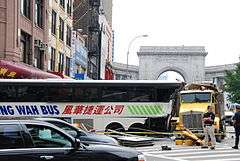 The Fung Wah Bus crash of June 23, 2008
The Fung Wah Bus crash of June 23, 2008 - On June 23, 2008, a bus loading passengers was struck by an out-of-control dump truck at the corner of Bowery and Canal Street in New York’s Chinatown. The force of the impact pushed the bus onto the sidewalk and into a bank. As the result of the accident, a sign attached to a light pole fell, injuring a 57-year-old woman; the woman later died as the result of a heart attack. Several people, including two police officers, were treated for minor injuries.[51][52][53] State Department of Transportation inspectors found that the dump truck, owned by CPQ Freight Systems, had eight mechanical issues including faulty brakes which led to the accident.[54]
- On March 12, 2011, a bus operated by World Wide Tours crashed on the New England Thruway, killing 15 people.[55]
- Also in March 2011, on the New Jersey Turnpike, a crash occurred in which the driver was killed and 40 injured, two critically.[56]
- On September 21, 2014, a bus, operated by Manhattan-based bus company AM USA Express, rolled over in Delaware. Two people died and 48 were hurt.[57]
After the August 2005 incident, the Massachusetts Department of Telecommunications and Energy instituted a policy of holding three surprise inspections per month on all bus companies that leave South Station in Boston. US Senator Chuck Schumer of New York proposed a four-point federal plan that includes surprise inspections and creating a national safety standard for bus operators. The city of New York may institute a similar policy; however, inspections would be difficult in New York City because the buses do not all leave the city from the same location.[58]
Shutdowns
In 2012, the Federal Motor Carrier Safety Administration began a crackdown on Chinatown bus lines.[12] In April 2013, the Federal Motor Carrier Safety Administration started an "Operation Quick Strike" squad that helped pinpoint wayward Chinatown bus drivers.[13]
- Apex Bus, Inc.
- On May 31, 2012, the Federal Motor Carrier Safety Administration announced that it had ordered the shutdown of Apex Bus, Inc., I-95 Coach Inc., New Century Travel Inc., and 23 other related entities due to safety violations.[59]
- Fung Wah
- On March 2, 2013, US Federal transportation officials shut down Fung Wah bus operations because it had broken a federal law by refusing to divulge safety records to the federal government.[13][60][61] In December 2014, the company was given permission to resume its bus operations under strict observation and limitations with service to restart in early 2015.[62][63] However, in July 2015, owner Peter Liang announced the service would end permanently.[64]
- Lucky Star
- On May 25, 2013, a bus was taken out of service due to a manhole cover being stuck on the undercarriage of one bus.[13] Less than two weeks later, on June 5, Lucky Star was shut down as well due to "Lucky Star’s flagrant disregard for motor coach passenger safety," said the letter from the Department of Transportation.[65] Lucky Star engaged in an extensive bus upgrade and driver program over the next five months, passed required inspections, and resumed operations in November 2013.[66]
One columnist for The Daily Beast criticized the Federal Motor Carrier Safety Administration's practices as overly harsh, stating that the it "targets" Chinatown bus companies because owners rarely speak much English. The columnist also alleged that the inspectors were also very strict in deciding which parts of the buses were defective, describing the inspectors as having confiscated several buses for minor issues.[13]
See also
- Coach USA, operator of the Eastern Shuttle service
References
- Austen, Ben (April 7, 2011). "The Megabus Effect". Bloomberg BusinessWeek. Retrieved May 17, 2013.
- Nicholas J. Klein; Andrew Zitcer. "Everything but the Chickens" (PDF). Edward J. Bloustein School of Planning and Public Policy. Retrieved October 30, 2015.
- Transportation Statistics Annual Report (1997) edited by Marsha Fenn, page 7
- "The Amazing Chinatown Bus Network". Motherboard. November 27, 2014. Retrieved October 30, 2015.
- Klein, Nicholas (2009). "Emergent Curbside Intercity Bus Industry". Transportation Research Record: Journal of the Transportation Research Board. 2111: 83–89. doi:10.3141/2111-11. S2CID 109266853.
- Carpenter, Mackenzie (August 16, 2006). "'Chinatown bus services' have grown quickly since 1998". Pittsburgh Post-Gazette.
- "Chinatown Bus Study" (PDF). New York City Department of Transportation. October 2009. Retrieved October 29, 2015.
- Nanos, Janelle (May 28, 2007). "Penny-Pinching Peril". NYMag.com. Retrieved October 29, 2015.
- Luo, Michael (February 21, 2004). "In Chinatown, a $10 Trip Means War; Weary Owners Struggle to Stay Afloat in Cutthroat Competition". New York Times. Retrieved April 17, 2014.
- Wilson, Michael (October 7, 2011). "Crime Scene: Collateral Damage in the Chinatown Bus Wars". The New York Times. Retrieved October 8, 2011.
- "Chinatown Buses: A History". Axis Chemicals. December 23, 2013. Retrieved October 30, 2015.
- Schliefer, Theodore (August 8, 2013). "Bus travel is picking up, aided by discount operators". Philadelphia Inquirer. Retrieved August 25, 2013.
- Epstein, Jim (November 2, 2013). "The Government's Cheap, Dishonest Campaign Against the Chinatown Bus Industry". The Daily Beast. Retrieved October 30, 2015.
- "Chinatown's bus war turning fatal". The Washington Times. March 7, 2004. Retrieved October 30, 2015.
- Gerson, Daniela (February 14, 2006). "If You Want To Vamoose in DeLuxe Style, You're in Luck". The New York Sun.
- Brulliard, Karin (November 24, 2006). "For Many Asians, an Atlantic City Pilgrimage". The Washington Post.
- Bailey, Steven (June 18, 2004). "Peter Pan is a bully". Boston Globe.
- Starcic, Janna (June 1, 2005). "Surviving the Motorcoach Rate-Cutting War". Metro Magazine. Retrieved October 30, 2015.
- Harlan, Heather (September 12, 2003). "Arsons May Signal Escalating NYC Shuttle Bus Feud". AsianWeek. Archived from the original on April 4, 2013. Retrieved January 24, 2007.
- McPhee, Michelle; Alice McQuillan (January 19, 2004). "Chinatown barrage stumps cops". Daily News. New York. Archived from the original on September 12, 2005. Retrieved January 24, 2007.
- "Feds' kung pow!". New York Post. October 23, 2008. Retrieved October 28, 2008.
- "Photos: Largest Gun Seizure In NYC History Involves Chinatown Buses, Stop & Frisk". Gothamist. August 19, 2013. Archived from the original on October 31, 2015. Retrieved October 30, 2015.
- "All Aboard, Next Stop Chinatown". Hyphen Magazine. August 1, 2007. Retrieved October 31, 2015.
- http://www.baltimoresun.com/news/local/baltimore_city/bal-te.md.ci.chinatown02mar02,0,2389532.story?page=1&track=rss
- "Columbia Spectator". Columbia Daily Spectator. February 27, 2004. Retrieved October 30, 2015.
- Clark, Patrick (July 17, 2014). "How Chinatown Buses Survived Competition, Regulation, and the Occasional Gang War". Businessweek.com. Retrieved October 30, 2015.
- Knafo, Saki (June 8, 2008). "Dreams and Desperation on Forsyth Street". The New York Times. Retrieved September 2, 2008.
- Hilgers, Lauren (October 13, 2014). "Chinatown's Kitchen Network". The New Yorker. Retrieved October 30, 2015.
- John Chin, Executive Director of the Philadelphia Chinatown Development Corporation. Telephone Interview, September 17, 2008.
- Miles E. Groves of the Downtown Neighborhood Association, Letter to Mayor Adrian M. Fenty, July 24, 2007
- Beehner, Lionel (June 9, 2010). "Chinatown Buses Unveiling New Routes". In Transit Blog. Retrieved October 29, 2015.
- Arino, Lisha (July 16, 2014). "City Will Begin Fining Illegal Chinatown Buses by August". DNAinfo New York. Archived from the original on January 6, 2016. Retrieved October 29, 2015.
- Taft, Chloe (July 2, 2014). "Ticket to a New York Casino License Is on the Chinatown Bus". The Huffington Post. Retrieved October 30, 2015.
- Assad, Matt (April 12, 2014). "Sands Casino cracks down on bus riders". The Morning Call. Allentown, PA. Retrieved January 18, 2020.
- Bowen, Alison, "Boltbus, Megabus and Fung-Wah: Curbside buses more dangerous: Buses that pick up passengers off the street are more dangerous than those that use a terminal, a new report found" Archived June 15, 2012, at the Wayback Machine, Metro newspaper, New York City, October 31, 2011
- Lewis, Sam, "Many Travelers Not Deterred by Deadly Bus Crashes" Archived January 26, 2013, at the Wayback Machine, WNYC news, New York City, Tuesday, March 15, 2011
- El-Ghobashy, Tamer (March 16, 2011). "NYPD Cracks Down on Buses". The Wall Street Journal. Retrieved March 16, 2011.
- Ellement, John (March 19, 2005). "Passengers Tell of Wild Bus Trip". Boston Globe. Retrieved January 24, 2007.
- Ross, Casey (August 16, 2005). "Flames engulf Fung Wah bus in Connecticut". Boston Globe. Retrieved January 24, 2007.
- Cherasore, Paul (January 27 – February 2, 2006). "Day of confusion for Chinatown bus riders". Downtown Express. Archived from the original on February 8, 2007. Retrieved January 24, 2007.
- "Bus Crash Injures Several, Causes Big Parkway Backups". The Pittsburgh Channel. August 15, 2006. Archived from the original on September 27, 2007.
- Milan Simonich (August 16, 2006). "10 hurt as tour bus crashes". Pittsburgh Post-Gazette.
- "34 hurt, driver cited for Fung Wah bus rollover in Auburn". Boston Globe. September 6, 2006. Archived from the original on March 28, 2009. Retrieved January 24, 2007.
- "Fung Wah bus company fined $31K for rollover". Boston Globe. October 31, 2006. Archived from the original on March 29, 2009. Retrieved January 24, 2007.
- "Fung Wah Bus Loses Wheels". WCVB-TV. January 3, 2007. Archived from the original on June 13, 2007.
- "Fung Wah Bus Crashes On Turnpike". WCVB-TV. February 14, 2007. Archived from the original on February 23, 2007.
- LeBlanc, Steve (September 12, 2006). "Chinatown Bus Line Agrees to Inspections". Fox News Channel. Associated Press.
- Kim Ring (February 19, 2007). "Passengers OK after bus fire on Turnpike". telegram.com.
- Ryan, Tim (March 23, 2007). "Fung Wah Bus Involved In Mishap". WCVB-TV. Archived from the original on July 17, 2007. Retrieved March 23, 2007.
- Armas, Genaro C. (May 20, 2007). "2 Dead, 32 Hurt in Pa. Bus Crash". washingtonpost.com. Retrieved October 30, 2015.
- Noah Bierman (June 24, 2008). "Boston-bound bus hit by truck in NYC; pedestrian is killed". The Boston Globe. Retrieved June 24, 2008.
- "Bus Crashes Into Bank In Manhattan". WNYW. June 23, 2008. Retrieved June 23, 2008.
- "One Dead, Four Injured When Bus Jumps Curb In Chinatown" Archived November 3, 2011, at the Wayback Machine, NY1 News, June 23, 2008
- El-Ghobashy, Tamer (June 25, 2008). "Rig in fatal crash had faulty brakes". Daily News. New York. Archived from the original on June 26, 2008. Retrieved June 25, 2008.
- Debusmann, Bernd (March 14, 2011). "Bus driver in deadly New York crash faces scrutiny". Reuters. Retrieved April 22, 2011.
- Paddock, Barry; Nestel, Matthew (March 14, 2011). "Another fatal bus crash, in N.J." NY Daily News. Retrieved October 29, 2015.
- "2 dead, 48 injured in Delaware bus crash". USA TODAY. September 21, 2014. Retrieved October 29, 2015.
- O'Leary, Lizzie (September 15, 2005). "Chinatown Buses Seek to Add Safety to Savings". WNYC. Retrieved January 24, 2007.
- "Gov't cracking down on unsafe bus companies operating along East Coast's I-95 corridor". The Washington Post. May 31, 2012. Retrieved May 31, 2012.
- "Feds close Fung Wah's doors". March 2, 2013. Retrieved October 29, 2015.
- Raw Signal coverage of Fung Wah shutdown, including other stories
- Newsham, Jack, "Fung Wah gets federal approval to return to the road", Boston Globe, December 18, 2014
- Connor Adams Sheets (December 18, 2014). "Fung Wah's Chinatown Buses To Return To Road In 2015". International Business Times. Retrieved December 19, 2014.
- Chris Fuchs. "Fung Wah Bus Company Shuts Down for Good". NBC News. Retrieved October 29, 2015.
- CBS's Boston Local blog, June 6, 2013
- "Lucky Star buses will roll once more". Boston Globe. Retrieved October 29, 2015.
Further reading
| Wikimedia Commons has media related to Chinatown bus lines. |
- Klein, Nicholas J. (2009). "Emergent Curbside Intercity Bus Industry" (PDF). Transportation Research Record: Journal of the Transportation Research Board. 2111 (1): 83–89. doi:10.3141/2111-11. Retrieved May 10, 2015.
- Brief History of Chinatown Bus, Gotobus, updated in 2011.